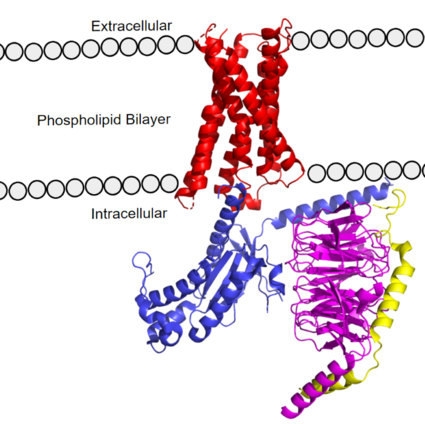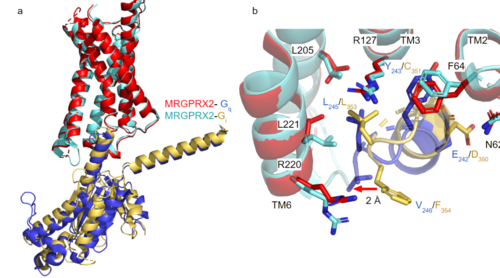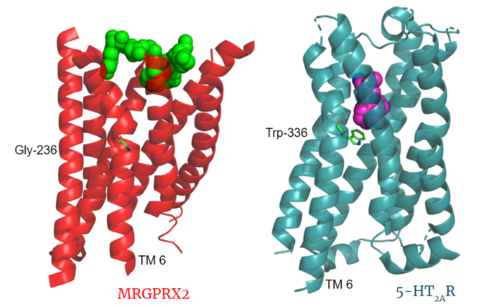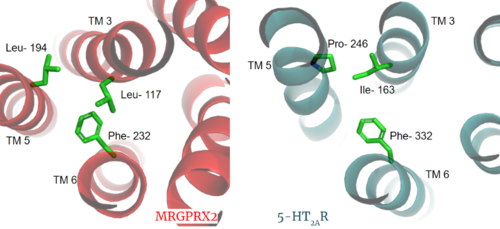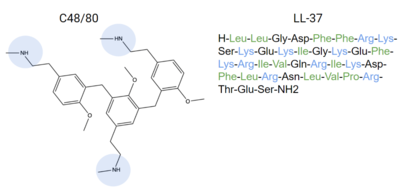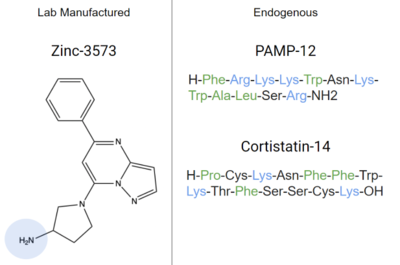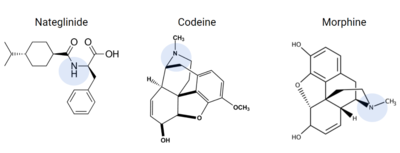Sandbox Reserved 1700
From Proteopedia
(Difference between revisions)
| Line 20: | Line 20: | ||
=== Transmembrane Domain === | === Transmembrane Domain === | ||
The [https://en.wikipedia.org/wiki/Transmembrane_domain#:~:text=A%20transmembrane%20domain%20(TMD)%20is,can%20adopt%20a%20different%20conformation. transmembrane domain] spans the cell membrane ('''Figure 1''') and it consists of <scene name='90/904305/Transmembrane_protein_c_and_l/2'>seven transmembrane α-helices</scene> and <scene name='90/904305/Ecl_and_icl/3'>6 loops</scene> (three extracellular loops, and three intracellular loops). The transmembrane helices are numbered 1-7 and contain special conserved motifs that are shared across other A family receptors. These motifs are expanded upon later, as they heavily contribute to the structure and therefore function of the transmembrane domain as a whole. | The [https://en.wikipedia.org/wiki/Transmembrane_domain#:~:text=A%20transmembrane%20domain%20(TMD)%20is,can%20adopt%20a%20different%20conformation. transmembrane domain] spans the cell membrane ('''Figure 1''') and it consists of <scene name='90/904305/Transmembrane_protein_c_and_l/2'>seven transmembrane α-helices</scene> and <scene name='90/904305/Ecl_and_icl/3'>6 loops</scene> (three extracellular loops, and three intracellular loops). The transmembrane helices are numbered 1-7 and contain special conserved motifs that are shared across other A family receptors. These motifs are expanded upon later, as they heavily contribute to the structure and therefore function of the transmembrane domain as a whole. | ||
| - | The extracellular region of the 7 transmembrane domain forms a single [https://en.wikipedia.org/wiki/Binding_site binding pocket] with <scene name='90/904305/Subpockets_1_and_2/4'>two sub-pockets</scene>. Sub-pocket 1 is negatively charged due to negatively charged <scene name='90/904305/Subpockets_1_and_2_d_and_e/2'>aspartate and glutamate</scene> residues (Asp-184 and Glu-164), while sub-pocket 2 contains hydrophobic amino acids which contribute to hydrophobic interactions between the ligand and protein. | + | The extracellular region of the 7 transmembrane domain forms a single [https://en.wikipedia.org/wiki/Binding_site binding pocket] with <scene name='90/904305/Subpockets_1_and_2/4'>two sub-pockets</scene>. Sub-pocket 1 is negatively charged due to negatively charged <scene name='90/904305/Subpockets_1_and_2_d_and_e/2'>aspartate and glutamate</scene> residues (Asp-184 and Glu-164), while sub-pocket 2 contains hydrophobic amino acids which contribute to hydrophobic interactions between the ligand and protein. The intracellular region ('''Figure 1''') is what connects the transmembrane helices with the G-protein. |
| - | The intracellular region ('''Figure 1''') is what connects the transmembrane helices with the G-protein. | + | |
| + | This GPCR has been modeled both as MRGPRX2 and MRGPRX4<ref name="Cao">PMID: 34789874</ref><ref name="Yang">PMID: 34789875</ref>, though much of this page focusses on MRGPRX2. X4 is found to mediate cholestatic itch compared to X2's regulation of mast cell degranulation and hypersensitivity itch-reactions<ref name="Cao">PMID: 34789874</ref>. X4 and X2 demonstrate nearly the same structural differences compared to that of other class A GPCRs. Interestingly, X4 can interact with negatively charged bile acids and is insensitive to the common X2 cationic agonists discussed later ('''Figure 7'''). | ||
=== G-Protein === | === G-Protein === | ||
| Line 97: | Line 98: | ||
== Function == | == Function == | ||
[[Image:Screen Shot 2022-04-162 at 2.49.26 PM.png|420px|right|thumb|'''Figure 8.'''Schematic representation of cellular response]] | [[Image:Screen Shot 2022-04-162 at 2.49.26 PM.png|420px|right|thumb|'''Figure 8.'''Schematic representation of cellular response]] | ||
| - | GPCRs undergo a conformational change in their 7TMD region upon ligand binding. This signal is then transduced to the G-protein allowing for downstream responses due to <scene name='90/904306/Interface_2/1'>interactions</scene> between the alpha subunit of the G-protein and the transmembrane protein which activates g-protein by GTP exchange. This downstream response may be in the form of release of small granules which can be received by a receptor to initiate a [https://proteopedia.org/wiki/index.php/Neurotransmitters#Serotonin_receptors%20Serotonin%20receptors pathological response] ( | + | GPCRs undergo a conformational change in their 7TMD region upon ligand binding. This signal is then transduced to the G-protein allowing for downstream responses due to <scene name='90/904306/Interface_2/1'>interactions</scene> between the alpha subunit of the G-protein and the transmembrane protein which activates g-protein by GTP exchange. This downstream response may be in the form of release of small granules which can be received by a receptor to initiate a [https://proteopedia.org/wiki/index.php/Neurotransmitters#Serotonin_receptors%20Serotonin%20receptors pathological response] ('''Figure 8''')<ref name="Porebski">PMID: 30619367</ref>. |
=== Before Activation === | === Before Activation === | ||
The culmination of different motifs observed in MRGPRX2 compared to other class A GPCRs leads to external membrane ligand binding. The MRGPRX2 GPCR undergoes a much smaller conformational change upon ligand binding compared to other Class A GPCRs due to surface level binding versus deep helix binding ('''Figure 9'''). This smaller change can be seen as only minor extracellular movement occurs in MRGRPX2 upon binding compared to other GPCRs which can undergo loop and helical conformational changes<ref name="Hoffmann">PMID: 18059316</ref>. | The culmination of different motifs observed in MRGPRX2 compared to other class A GPCRs leads to external membrane ligand binding. The MRGPRX2 GPCR undergoes a much smaller conformational change upon ligand binding compared to other Class A GPCRs due to surface level binding versus deep helix binding ('''Figure 9'''). This smaller change can be seen as only minor extracellular movement occurs in MRGRPX2 upon binding compared to other GPCRs which can undergo loop and helical conformational changes<ref name="Hoffmann">PMID: 18059316</ref>. | ||
| Line 103: | Line 104: | ||
=== After Activation === | === After Activation === | ||
| - | After ligand binding and transmembrane protein activation, this signal is transmitted to the alpha subunit of the G-protein which undergoes chemical and conformational changes. The alpha subunit is initially bound with GDP which is then physically replaced by GTP leading to conformational changes. These changes can be seen in this [https://youtu.be/k4fjSZV_-OQ video] of a G-protein alpha subunit activation derived from common rats. This video was constructed by one of the page's authors using PDB files 1bof and 1cip. | + | After ligand binding and transmembrane protein activation, this signal is transmitted to the alpha subunit of the G-protein which undergoes chemical and conformational changes. The alpha subunit is initially bound with GDP which is then physically replaced by GTP leading to conformational changes. These changes can be seen in this [https://youtu.be/k4fjSZV_-OQ video] of a G-protein alpha subunit activation derived from common rats. This video was constructed by one of the page's authors using PDB files [https://www.rcsb.org/structure/1BOF 1bof] and [https://www.rcsb.org/structure/1CIP 1cip]. |
[[Image:Screen Shot 2022-03-282 at 6.59.44 PM.png|500px|center|thumb|'''Figure 9.''' Overlay of unbound (transparent) and bound (opaque) transmembrane proteins of both MRGRPX2 (left) and 5-HT2AR (right). PDBs: (MRGPRX2): 7s8l and (5HT2A): 6wha.]] | [[Image:Screen Shot 2022-03-282 at 6.59.44 PM.png|500px|center|thumb|'''Figure 9.''' Overlay of unbound (transparent) and bound (opaque) transmembrane proteins of both MRGRPX2 (left) and 5-HT2AR (right). PDBs: (MRGPRX2): 7s8l and (5HT2A): 6wha.]] | ||
Current revision
MRGPRX2 Human Itch G-Protein Coupled Receptor (GPCR)
| |||||||||||
References
- ↑ Tuteja N. Signaling through G protein coupled receptors. Plant Signal Behav. 2009 Oct;4(10):942-7. doi: 10.4161/psb.4.10.9530. Epub 2009, Oct 14. PMID:19826234 doi:http://dx.doi.org/10.4161/psb.4.10.9530
- ↑ Hauser AS, Attwood MM, Rask-Andersen M, Schioth HB, Gloriam DE. Trends in GPCR drug discovery: new agents, targets and indications. Nat Rev Drug Discov. 2017 Dec;16(12):829-842. doi: 10.1038/nrd.2017.178. Epub, 2017 Oct 27. PMID:29075003 doi:http://dx.doi.org/10.1038/nrd.2017.178
- ↑ 3.0 3.1 3.2 3.3 Porebski G, Kwiecien K, Pawica M, Kwitniewski M. Mas-Related G Protein-Coupled Receptor-X2 (MRGPRX2) in Drug Hypersensitivity Reactions. Front Immunol. 2018 Dec 20;9:3027. doi: 10.3389/fimmu.2018.03027. eCollection, 2018. PMID:30619367 doi:http://dx.doi.org/10.3389/fimmu.2018.03027
- ↑ 4.0 4.1 4.2 4.3 4.4 4.5 4.6 Dondalska A, Ronnberg E, Ma H, Palsson SA, Magnusdottir E, Gao T, Adam L, Lerner EA, Nilsson G, Lagerstrom M, Spetz AL. Amelioration of Compound 48/80-Mediated Itch and LL-37-Induced Inflammation by a Single-Stranded Oligonucleotide. Front Immunol. 2020 Sep 30;11:559589. doi: 10.3389/fimmu.2020.559589. eCollection, 2020. PMID:33101278 doi:http://dx.doi.org/10.3389/fimmu.2020.559589
- ↑ 5.0 5.1 5.2 5.3 5.4 5.5 5.6 McNeil BD, Pundir P, Meeker S, Han L, Undem BJ, Kulka M, Dong X. Identification of a mast-cell-specific receptor crucial for pseudo-allergic drug reactions. Nature. 2015 Mar 12;519(7542):237-41. doi: 10.1038/nature14022. Epub 2014 Dec 17. PMID:25517090 doi:http://dx.doi.org/10.1038/nature14022
- ↑ 6.00 6.01 6.02 6.03 6.04 6.05 6.06 6.07 6.08 6.09 6.10 6.11 6.12 6.13 Cao C, Kang HJ, Singh I, Chen H, Zhang C, Ye W, Hayes BW, Liu J, Gumpper RH, Bender BJ, Slocum ST, Krumm BE, Lansu K, McCorvy JD, Kroeze WK, English JG, DiBerto JF, Olsen RHJ, Huang XP, Zhang S, Liu Y, Kim K, Karpiak J, Jan LY, Abraham SN, Jin J, Shoichet BK, Fay JF, Roth BL. Structure, function and pharmacology of human itch GPCRs. Nature. 2021 Dec;600(7887):170-175. doi: 10.1038/s41586-021-04126-6. Epub 2021, Nov 17. PMID:34789874 doi:http://dx.doi.org/10.1038/s41586-021-04126-6
- ↑ 7.0 7.1 7.2 7.3 7.4 7.5 7.6 7.7 7.8 7.9 Yang F, Guo L, Li Y, Wang G, Wang J, Zhang C, Fang GX, Chen X, Liu L, Yan X, Liu Q, Qu C, Xu Y, Xiao P, Zhu Z, Li Z, Zhou J, Yu X, Gao N, Sun JP. Structure, function and pharmacology of human itch receptor complexes. Nature. 2021 Dec;600(7887):164-169. doi: 10.1038/s41586-021-04077-y. Epub 2021, Nov 17. PMID:34789875 doi:http://dx.doi.org/10.1038/s41586-021-04077-y
- ↑ Kamato D, Thach L, Bernard R, Chan V, Zheng W, Kaur H, Brimble M, Osman N, Little PJ. Structure, Function, Pharmacology, and Therapeutic Potential of the G Protein, Galpha/q,11. Front Cardiovasc Med. 2015 Mar 24;2:14. doi: 10.3389/fcvm.2015.00014. eCollection, 2015. PMID:26664886 doi:http://dx.doi.org/10.3389/fcvm.2015.00014
- ↑ Trzaskowski B, Latek D, Yuan S, Ghoshdastider U, Debinski A, Filipek S. Action of molecular switches in GPCRs--theoretical and experimental studies. Curr Med Chem. 2012;19(8):1090-109. doi: 10.2174/092986712799320556. PMID:22300046 doi:http://dx.doi.org/10.2174/092986712799320556
- ↑ 10.0 10.1 Katritch V, Fenalti G, Abola EE, Roth BL, Cherezov V, Stevens RC. Allosteric sodium in class A GPCR signaling. Trends Biochem Sci. 2014 May;39(5):233-44. doi: 10.1016/j.tibs.2014.03.002. Epub , 2014 Apr 21. PMID:24767681 doi:http://dx.doi.org/10.1016/j.tibs.2014.03.002
- ↑ Rovati GE, Capra V, Neubig RR. The highly conserved DRY motif of class A G protein-coupled receptors: beyond the ground state. Mol Pharmacol. 2007 Apr;71(4):959-64. doi: 10.1124/mol.106.029470. Epub 2006 Dec , 27. PMID:17192495 doi:http://dx.doi.org/10.1124/mol.106.029470
- ↑ Naranjo AN, Chevalier A, Cousins GD, Ayettey E, McCusker EC, Wenk C, Robinson AS. Conserved disulfide bond is not essential for the adenosine A2A receptor: Extracellular cysteines influence receptor distribution within the cell and ligand-binding recognition. Biochim Biophys Acta. 2015 Feb;1848(2):603-14. doi: 10.1016/j.bbamem.2014.11.010., Epub 2014 Nov 16. PMID:25445670 doi:http://dx.doi.org/10.1016/j.bbamem.2014.11.010
- ↑ Olivella M, Caltabiano G, Cordomi A. The role of Cysteine 6.47 in class A GPCRs. BMC Struct Biol. 2013 Mar 15;13:3. doi: 10.1186/1472-6807-13-3. PMID:23497259 doi:http://dx.doi.org/10.1186/1472-6807-13-3
- ↑ Hoffmann C, Zurn A, Bunemann M, Lohse MJ. Conformational changes in G-protein-coupled receptors-the quest for functionally selective conformations is open. Br J Pharmacol. 2008 Mar;153 Suppl 1:S358-66. doi: 10.1038/sj.bjp.0707615. Epub, 2007 Dec 3. PMID:18059316 doi:http://dx.doi.org/10.1038/sj.bjp.0707615
- ↑ Gonzalez-Rey E, Chorny A, Robledo G, Delgado M. Cortistatin, a new antiinflammatory peptide with therapeutic effect on lethal endotoxemia. J Exp Med. 2006 Mar 20;203(3):563-71. doi: 10.1084/jem.20052017. Epub 2006 Feb, 21. PMID:16492802 doi:http://dx.doi.org/10.1084/jem.20052017
